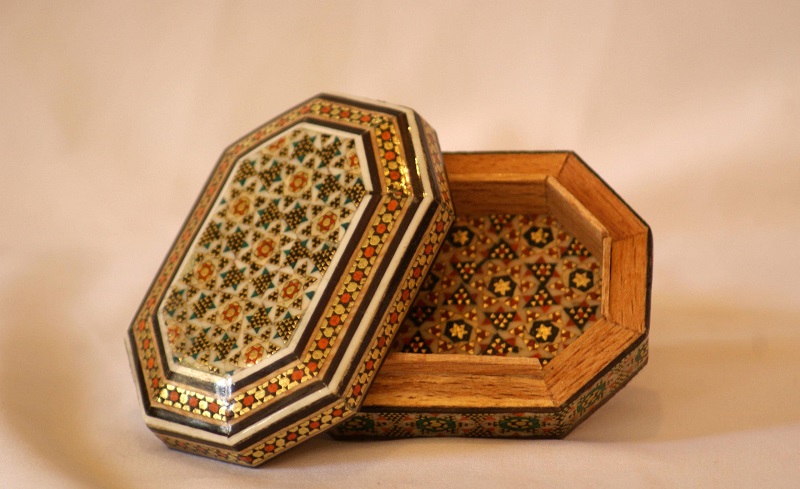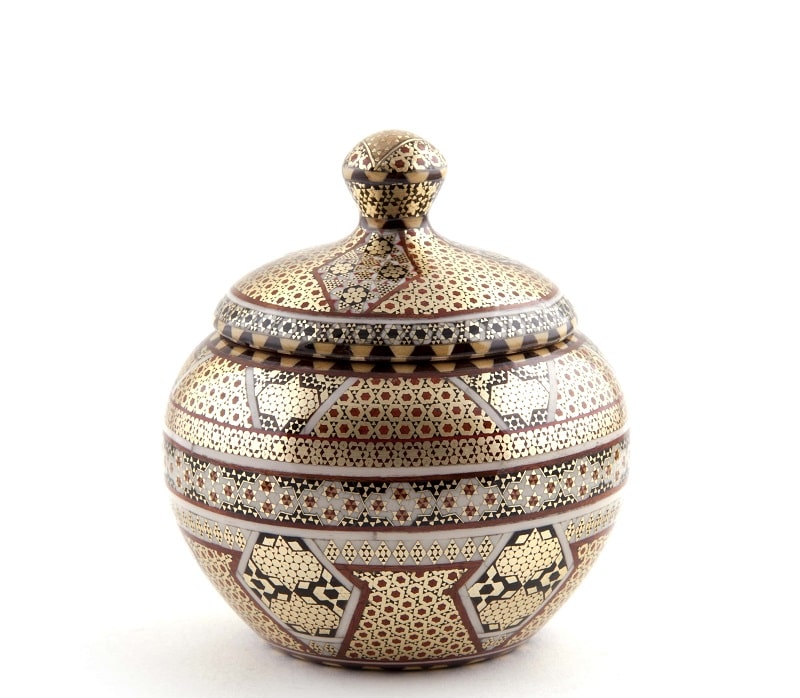Khatamkari Introduction
Khatamkari, as original Persian art, is the art of embellishing or covering the surface of wood and copper with tiny triangle shape mosaic works. The smaller the size of these triangles are, the more precision and delicacy are needed to place pieces together; hence, the Khatam’s value will increase.
History of Khatamkari
There are various opinions and narrations about the originator and inventor of Khatam, but it is not exactly clear who made it for the first time. The Persian encyclopedia states: The beginning of such an art is unknown also the said story has intertwined with myths. Some master calligraphers still believe that the art of calligraphy is the miracle of the Prophet Ibrahim. The first founded Khatam date back to the early Islamic period, and are maintained in museums in Cairo, and Berlin, at present.
The art of Khatamkari has been created in the vast country of Persia about 1000 years ago in Shiraz, and it has been very famous. Before the Safavid era, the art of Khatamkari was popular only in Shiraz, however, the peak of its prosperity and development occurred during the Safavid period. After a while, the Khatamkari art of Shiraz was transmitted to Isfahan and was admired by the people and artists there. The history of Khatam in Isfahan dates back to the Seljuk period.

Ancient Samples on Khatam
Among the remained relics, we can mention the nave’s door of the Isfahan Grand Mosque. In the Safavid era, Khatam Kari reached its peak, hence, unique artworks were inherited for future generations, such as Chaharbagh School’s door, one of the outstanding works of that period, locating in Bazaar-e Honar at present. The tomb of Sheikh Safi al-Din in Ardabil Province is another treasure of Khatamkari where masters from Isfahan have worked. During the Qajar period, although the art of Khatamkari declined slightly, there are still works such as the Seyyed Isfahan Mosque’s door from that duration.
During the first Pahlavi era, masters from Shiraz and Isfahan plastered all the doors and walls of the Marble Palace hall in Tehran; they decorated all the objects in this room, such as the hanger and the desk with Khatam artworks. In the second Pahlavi period, skillful artists have worked hard to keep the Khatamkari stable, and the art of Khatamkari reached its peak of beauty during this period again. Initially, Khatam were made by using sizeable triangles put together, but gradually, with the artists’ advancement, the dimensions of the triangles became smaller and smaller.

Today‘s Khatam Products
Khatamkari can be accomplished on various surfaces and objects. At present, objects made of copper, wood, and pottery surfaces are mainly used to create the Khatam crafts in Isfahan. In the case of Khatamkari copper utensils in Isfahan, we can mention nut bowls, plates, as well as dessert plates, however, the variety of copper products with Khatamkari is uncountable. The wooden products with Khatamkari include Khatamkari clocks, backgammon, and chess, pen, jewelry box, tissue box, and others.
In Isfahan, in addition to Khatam objects that are made in Shirazi style, some of Khatam artifacts have been combined with silver and enamel, such as Khatami boxes on which miniature paintings are painted and oiled, which does not exist in Shiraz by the way. Khatami products are one of the most popular gifts and souvenirs from Persia. Khatamkari is also known as an identity of Persian culture and civilization; hence, it is a worthy craft to get everyone acquainted with Persian art.

